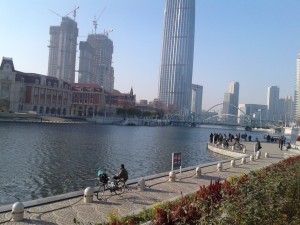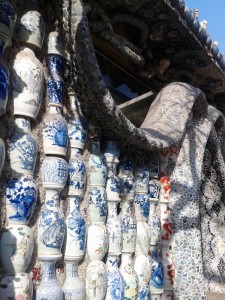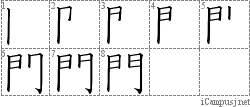Only a half and hour train ride outside of Beijing lies an amazing city (that almost no one outside of China has ever heard of) called Tianjin. As it is so close to Beijing, I thought it would be just like it. You know, the same types of buildings, architecture, people, food, and so forth. As it turned out, the two cities are extremely different.
Can you guess which of the pictures are from Tianjin?
It’s hard to be sure, huh? Well, the truth is that they’re all from Tianjin. Without the Chinese characters on buildings and taxi’s, I could have been in any city in Europe. In particular, I felt like I was staying in Greece because our hostel was built to look like a Greek villa (see picture above!).
A long time ago it was occupied by many foreign countries at once. All those foreign people (外国人) certainly left their mark on the city. We saw many French style buildings near our hotel and intentionally went to see both the Tianjin eye (sound familiar?) and the Italian Style town. Even the skyscrapers could belong in any American or European city.
Despite how foreign the city looked, we only saw a handful of other foreigners. There were a lot of tourists, but they were primarily Chinese. How was that possible? Tianjin was perhaps the most foreign looking city I’d seen in China so far (though I’m reserving my final judgement until after I visit Shanghai). Though, that could be the reason in it of itself. Foreigners don’t often come here because it is so similar to where they come from, and because there aren’t as many business opportunities as in Shanghai or Hong Kong.
They don’t know what they are missing. It’s not just a city of foreign buildings either. The people of Tianjin have taken those buildings and made them their own. One of the most well known (and literal) example of this phenomenon is called China House. We found it by accident (of course). We literally passed it on our taxi ride to our hostel and thought it looked interesting enough to come back to. A Chinese man took an old French style building and covered it completely (and I do mean completely) in ancient Chinese porcelain. It is now a porcelain museum that showcases this type of ancient art in a totally innovative way. The word “China” in the photo below is made of concrete and covered in artfully broken pieces of porcelain.
I guess Tianjin is sort of an outward example of how China sees itself today. It wants to be a modern country, but with Chinese characteristics. It’s a daunting challenge faced by many countries and people around the world. How do you advance and better yourself while still maintaining your own essence and culture? Perhaps China has the right idea; take the old and make it your own.







